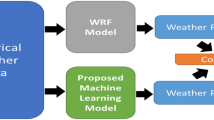Abstract
Quantitative and qualitative monthly precipitation forecasts are produced with ANFIS. To select the proper input variable set from 30 variables, including climatological and hydrological monthly recording data, the forward selection method, which is a wrapper method for feature selection, is applied. The error analysis of the results from training and checking the data sets suggests that 3 variables can be used as a suitable number of inputs for ANFIS, and the best five 3-input-variable sets were selected. The quantitative monthly precipitation forecasts were computed using each 3-input-variable set, and the ensemble averaging method over the five forecasts was used for calculations to reduce the uncertainties in the forecasts and to remove the negative rainfall forecasts. A qualitative forecast that is computed with the quantitative forecast also produced three types of categories that describe the next month’s precipitation condition and was compared with data from the weather agency of Korea.





Similar content being viewed by others
References
Bacanli UG, Firat M, Dikbas F (2009) Adaptive neuro-fuzzy inference system for drought forecasting. Stoch Environ Res Risk Assess 23(8):1143–1154. doi:10.1007/s00477-008-0288-5
Bae D-H, Jeong DM, Kim G (2007) Monthly dam inflow forecasts using weather forecasting information and neuro-fuzzy technique. Hydrol Sci J 52(1):99–113
Bodri L, Cermak V (2000) Prediction of extreme precipitation using a neural network: application to summer flood occurrence in Moravia. Adv Eng Softw 31(5):311–321. doi:10.1016/s0965-9978(99)00063-0
Chang L-C, Chang F-J (2001) Intelligent control for modelling of real-time reservoir operation. Hydrol Process 15:1621–1634
Chang Y-T, Chang L-C, Chang F-J (2005) Intelligent control for modeling of real-time reservoir operation, part II: artificial neural network with operating rule curves. Hydrol Process 19(7):1431–1444
Chen SM (1996) Forecasting enrollments based on fuzzy time series. Fuzzy Set Syst 81(3):311–319. doi:10.1016/0165-0114(95)00220-0
Franks SW, Gineste P, Beven KJ, Merot P (1998) On constraining the predictions of a distributed model: the incorporation of fuzzy estimates of saturated areas into the calibration process. Water Resour Res 34(4):787–797
Furundzic D (1998) Application example of neural networks for time series analysis: rainfall-runoff modeling. Signal Process 64(3):383–396. doi:10.1016/s0165-1684(97)00203-x
Gautam DK, Holz KP (2001) Rainfall-runoff modelling using adaptive neuro-fuzzy systems. J Hydroinf 3:3–10
Hasebe M, Nagayama Y (2002) Reservoir operation using the neural network and fuzzy systems for dam control and operation support. Adv Eng Softw 33(5):245–260. doi:10.1016/s0965-9978(02)00015-7
Jain SK, Das A, Srivastava DK (1999) Application of ANN for reservoir inflow prediction and operation. J Water Resour Plann Manag 125(5):263–271
Jang JSR (1993) ANFIS: adaptive-network-based fuzzy inference system. IEEE Trans Syst Man Cybern 23(3):665–685
Jang J-SR, Sun C-T, Mizutani E (1997) Neuro-fuzzy and soft computing: a computational approach to learning and machine intelligence. MATLAB curriculum series. Prentice Hall, Upper Saddle River
Kisi O, Nia AM, Gosheh MG, Tajabadi MRJ, Ahmadi A (2012) Intermittent streamflow forecasting by using several data driven techniques. Water Resour Manag 26(2):457–474. doi:10.1007/s11269-011-9926-7
Korea Meteorological Administration (2009) Long-Range Forecast: 1-month & 3-month Forecast. http://web.kma.go.kr/eng/lon/lon_01_01.jsp. Accessed June 3 2009
Luk KC, Ball JE, Sharma A (2001) An application of artificial neural networks for rainfall forecasting. Math Comput Model 33(6–7):683–693. doi:10.1016/s0895-7177(00)00272-7
May RJ, Maier HR, Dandy GC, Fernando TMKG (2008) Non-linear variable selection for artificial neural networks using partial mutual information. Environ Model Software 23(10–11):1312–1326
Moustris KP, Larissi IK, Nastos PT, Paliatsos AG (2011) Precipitation forecast using artificial neural networks in specific regions of Greece. Water Resour Manag 25(8):1979–1993. doi:10.1007/s11269-011-9790-5
Nayak PC, Sudheer KP, Rangan DM, Ramasastri KS (2005) Short-term flood forecasting with a neurofuzzy model. Water Resour Res 41(4):W04004. doi:04010.01029/02004WR003562. doi:W04004
Nayak PC, Sudheer KP, Jain SK (2007) Rainfall-runoff modeling through hybrid intelligent system. Water Resour Res 43:W07415. doi:doi:10.1029/2006WR004930
Raman H, Chandramouli V (1996) Deriving a general operating policy for reservoirs using neural network. J Water Resour Plann Manag 122(5):342–347
Sajikumar N, Thandaveswara BS (1999) A non-linear rainfall-runoff model using an artificial neural network. J Hydrol 216(1–2):32–55. doi:10.1016/S0022-1694(98)00273-X
Sanikhani H, Kisi O (2012) River flow estimation and forecasting by using two different adaptive neuro-fuzzy approaches. Water Resour Manag 26(6):1715–1729. doi:10.1007/s11269-012-9982-7
Shu C, Ouarda TBMJ (2008) Regional flood frequency analysis at ungauged sites using the adaptive neuro-fuzzy inference system. J Hydrol 349(1–2):31–43
Takagi T, Sugeno M (1985) Fuzzy identification of systems and its applications to modeling and control. IEEE Trans Syst Man Cybern 15(1):116–132
The International Research Institute for Climate and Society (2009) The Science and Practice of Seasonal Climate Forecasting at the IRI. http://iri.columbia.edu/climate/forecast/tutorial2/. Accessed July 20 2009
Yurdusev MA, Firat M (2009) Adaptive neuro fuzzy inference system approach for municipal water consumption modeling: an application to Izmir, Turkey. J Hydrol 365(3–4):225–234
Acknowledgement
This research was supported by a grant (11-TI-C06) from Construction Technology Innovation Program funded by Ministry of Land, Transport and Maritime Affairs of Korean government.
Author information
Authors and Affiliations
Corresponding author
Rights and permissions
About this article
Cite this article
Jeong, C., Shin, JY., Kim, T. et al. Monthly Precipitation Forecasting with a Neuro-Fuzzy Model. Water Resour Manage 26, 4467–4483 (2012). https://doi.org/10.1007/s11269-012-0157-3
Received:
Accepted:
Published:
Issue Date:
DOI: https://doi.org/10.1007/s11269-012-0157-3




